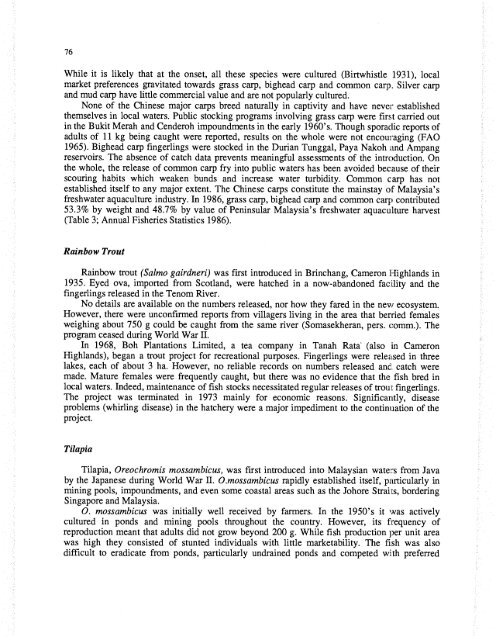Exotic Aquatic Organisms - International Development Research ...
Exotic Aquatic Organisms - International Development Research ...
Exotic Aquatic Organisms - International Development Research ...
You also want an ePaper? Increase the reach of your titles
YUMPU automatically turns print PDFs into web optimized ePapers that Google loves.
76<br />
While it is likely that at the onset, all these species were cultured (Birtwhistle 1931), local<br />
market preferences gravitated towards grass carp, bighead carp and common carp. Silver carp<br />
and mud carp have little commercial value and are not popularly cultured.<br />
None of the Chinese major carps breed naturally in captivity and have neve] established<br />
themselves in local waters. Public stocking programs involving grass carp were first carried out<br />
in the Bukit Merah and Cenderoh impoundments in the early 1960's. Though sporadic reports of<br />
adults of 11 kg being caught were reported, results on the whole were not encouraging (FAO<br />
1965). Bighead carp fingerlings were stocked in the Durian Tunggal, Paya Nakoh and Ampang<br />
reservoirs. The absence of catch data prevents meaningful assessments of the introduction. On<br />
the whole, the release of common carp fry into public waters has been avoided because of their<br />
scouring habits which weaken bunds and increase water turbidity. Common c arp has not<br />
established itself to any major extent. The Chinese carps constitute the mainstay of Malaysia's<br />
freshwater aquaculture industry. In 1986, grass carp, bighead carp and common carp contributed<br />
53.3% by weight and 48.7% by value of Peninsular Malaysia's freshwater aquaculture harvest<br />
(Table 3; Annual Fisheries Statistics 1986).<br />
Rainbow Trout<br />
Rainbow trout (Salmo gairdneri) was first introduced in Brinchang, Cameron Highlands in<br />
1935. Eyed ova, imported from Scotland, were hatched in a now-abandoned facility and the<br />
fingerlings released in the Tenom River.<br />
No details are available on the numbers released, nor how they fared in the new ecosystem.<br />
However, there were unconfirmed reports from villagers living in the area that berried females<br />
weighing about 750 g could be caught from the same river (Somasekheran, pers. comm.). The<br />
program ceased during World War II.<br />
In 1968, Boh Plantations Limited, a tea company in Tanah Rata (also in Cameron<br />
Highlands), began a trGut project for recreational purposes. Fingerlings were released in three<br />
lakes, each of about 3 ha. However, no reliable records on numbers released and. catch were<br />
made. Mature females were frequently caught, but there was no evidence that the fish bred in<br />
local waters. Indeed, maintenance of fish stocks necessitated regular releases of trout fingerlings.<br />
The project was terminated in 1973 mainly for economic reasons. Significantly, disease<br />
problems (whirling disease) in the hatchery were a major impediment to the continuation of the<br />
project.<br />
Tilapia<br />
Tilapia, Oreochromis mossambicus, was first introduced into Malaysian waters from Java<br />
by the Japanese during World War II. O.mossambicus rapidly established itself, particularly in<br />
mining pools, impoundments, and even some coastal areas such as the Johore Straits, bordering<br />
Singapore and Malaysia.<br />
0. mossambicus was initially well received by farmers. In the 1950's it was actively<br />
cultured in ponds and mining pools throughout the country. However, its frequency of<br />
reproduction meant that adults did not grow beyond 200 g. While fish production per unit area<br />
was high they consisted of stunted individuals with little marketability. The fish was also<br />
difficult to eradicate from ponds, particularly undrained ponds and competed with preferred

















